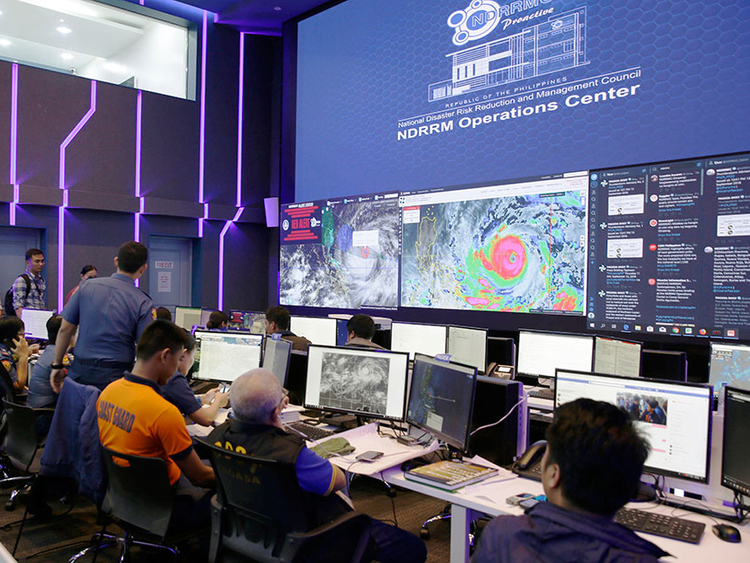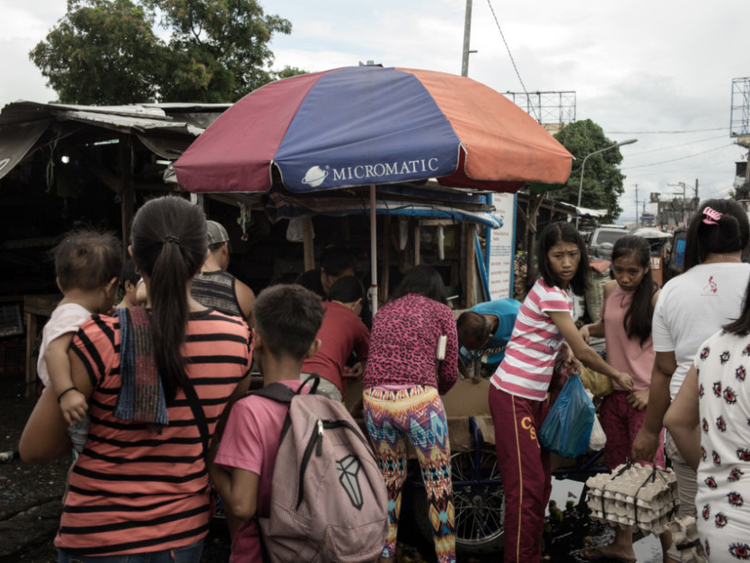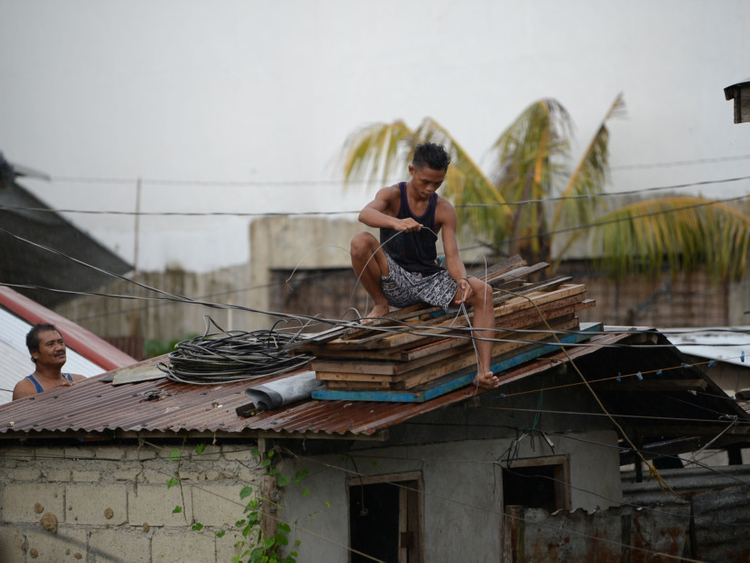
Update:
Death toll in Philippines upto 16
More than 20 hours after landfall, at least 16 deaths were reported, but there were no signs of the kind of devastation wreaked by Typhoon Haiyan five years ago.
Stay safe and updated as #OmpongPH brings heavy winds and rains. Here are some information about emergency numbers, tips, and updates on current situation that you need to take note of.https://t.co/e6GR6E7mA0
— Twitter Philippines (@TwitterPH) September 14, 2018
China, Hong Kong prepare for Typhoon Mangkhut
VIDEO: Residents in the fishing village of Tai O in Hong Kong prepare for the arrival of Super Typhoon #Mangkhut pic.twitter.com/2pJg7xc7yc
— AFP news agency (@AFP) September 15, 2018
Philippine official says Typhoon Mangkhut has left at least 12 people dead
An official says Typhoon Mangkhut (local name: Ompong) has left at least 12 people dead in the northern Philippines, mostly in landslides and houses that got pummeled by the storm's fierce winds and rain.
Presidential adviser Francis Tolentino says the dead included an infant and another child who were among four people killed in a landslide in Nueva Vizcaya, one of several provinces battered by the typhoon on Saturday.
Tolentino says that at least two other people are missing and that the death toll could climb to 16 once other casualty reports are verified.
He says about 87,000 people evacuated from high-risk areas and advised them not to return home until the lingering danger has passed.
Mangkhut slammed ashore before dawn Saturday in Cagayan province in the northeast and is on target to hit southern China on Sunday.
Earlier, the authorities had put the toll at three.
Rescue workers were seen clearing roads of debris, felled trees and toppled electric posts caused by strong winds due to the "supertyphoon" as they try to reach Baggao town in Cagayan province, north of Manila September 15, 2018.
Mangkhut slammed into the northern Philippines, with violent winds and raging floodwaters due to torrential rains, as authorities warned millions in its path of potentially heavy destruction.
This is what Typhoon Mangkhut, the strongest storm anywhere on the planet in 2018, is doing to rivers in the Philippines https://t.co/gzFviR3bx4 pic.twitter.com/EiQDVkIUfG
— CNN (@CNN) September 15, 2018
Aftermath
Initial reports show badly battered homes, roofs blown away and an airport terminal damaged by the Mangkhut in northern Philippines, as the "supertyphoon", equivalent to a Category 5 hurricane, made landfall and barelled ashore with strong winds and heavy rain.
Posts on social media from downtown Tugegarao City, the capital of ther nothern Cagayan Valley Region, showed roofs collapsing after being blasted away by what weathermen said is this year's strongest storm so far.
Power was down in the city and most of neighbouring provinces, as the storm battered the north of the Philippines' main island of Luzon, forcing at least 4,000 people to flee their homes and seek shelter in designated evacuation centres.
Typhoon Mangkhut: trees down on road pic.twitter.com/lKPcms2dkG
— Hannah Beech (@hkbeech) September 14, 2018
There were reports of damage sustained by Tuguegarao's airport terminal.
Here's a video of the heavy rains and howling winds hammering the town of Bacarra in Ilocos Norte province posted at 6.06 am, September 15.
Weathermen said Mangkhut has kept its strength and speed while on its way out of the Philippine landmass, state weather bureau Pag-Asa said early Saturday afternoon.
As of 9am Dubai time, the eye of Mangkhut was seen 85 kilometers west of Laoag City, Ilocos Norte.
It packs maximum sustained winds of 170 kilometers per hour near the center and gusts of up to 260 kph.
Moving west northwest at 25 kilometers per hour, the typhoon is predicted to exit the Philippine area of responsibility on Saturday night.
The biggest tropical cyclone of the year, Mangkhut hammered the provinces of Cagayan, Abra and Ilocos in nothern Philippines from about 1:40 am on Saturday. It ripped out roofs, felled trees, knocked out power and communication lines and triggered floods and landslides in northern Luzon.
Initial images show badly-damaged homes of low-income families while the entire roof of a petrol station was completely blown away.
The storm landed at Baggao around 1:40 am (1740 Friday GMT) with sustained winds of 205 kilometers per hour, said weather service PAGASA.
Forecasters say the typhoon, with winds of 205km/h (130 mph) and gusts of up to 255 km/h, is the strongest storm of 2018 so far.
More than four million people are directly in the path of the storm and thousands have been evacuated.
Officials have warned of storm surges of up to 6m (20ft) and "very heavy damage" to vulnerable structures.
They have raised alert levels to the second-highest - signal four - in Cagayan, northern Isabela, Apayao and Abra provinces.
Earlier on Friday, the Philippines government raced to ensure contingencies were in place, as Typhoon Mangkhut started to make its presence felt in the north.
Talking to Gulf News, Governor Joy Biernos of Abra province said that as of 4.30pm, the typhoon’s powerful effects are yet to be felt. “So far, we are having drizzles but we are not taking any chances,” she said, adding her province is prepared for any eventualities.
In the municipality of Rizal in Cagayan, Vice Mayor Joel Ruma told Gulf News that the strong winds were already being felt in their area, at 4.50pm.
“We hope this is not as powerful as typhoon Lawin (International name: Haima),” he said. “In any event, the province if prepared,” he added.
Lawin struck northern Philippines in October 2016 and its powerful 250kph winds left 19 people dead.
Pagasa said that Mangkhut, at a 900km diameter size, is bigger than typhoon Haiyan that struck Visayas in 2013.
Currently, Mangkhut is moving in a west-northwest direction at 25km/h and is expected to deliver its fury with maximum sustained winds of 205m/h near the centre, and gusts of up to 255m/h.
Calamity ready
On Thursday, President Rodrigo Duterte held a command conference in Camp Aguinaldo in Quezon City, to get updates of steps taken by officials to face Mangkhut.
During the meeting, the president ordered some of the Cabinet members to be on site.
Transport Secretary Arthur Tugade and Labour Secretary Silvestre Bello III hail from the provinces of Cagayan and Isabela respectively. Tugade said transport trucks close to the area are on standby for several days now.
Pictures: Philippines brace for Typhoon Mangkhut
National Disaster Risk Reduction and Management Council (NDRRMC) Undersecretary Ricardo Jalad said there are around 4.3 million residents in these provinces. Ilocos Norte of Ilocos Sur in the Ilocos region, as well as Abra, Kalinga, Mountain Province and Ifugao in the Cordilleras are expected to be affected.
As of Friday afternoon, typhoon signal No. 3 has been raised in these areas while other areas in Rizal, Nueva Ecija, Nueva Viscaya and Bulacan provinces are on signal No. 2.
“We expect some 824,000 individuals to be directly affected by the typhoon. Most of these are the poor, who have houses made of light materials,” Jalad said.
They’re also likely to be at the mercy of floods and have their dwellings destroyed by the powerful winds.
“We’re already moving these at-risk residents to the more than 1,742 evacuation centres,” he said.
Public Works Secretary Mark Villar said emergency construction equipment has been made available to ensure minimal disruption of road networks, which are vital for delivering relief to affected areas.
Foreign Secretary Allan Peter Cayetano said his agency will be making satellite phones available, in case communication networks are down.
The country’s previous experience with typhoon Lawin — with relief materials delayed in reaching the affected residents — taught that communications and transport are vital during calamities.














